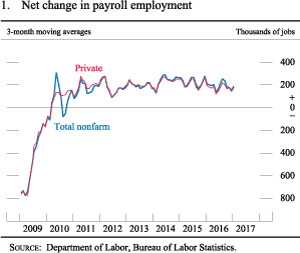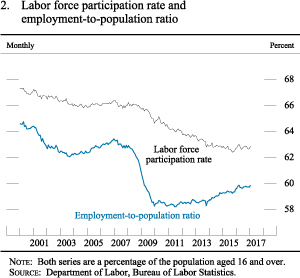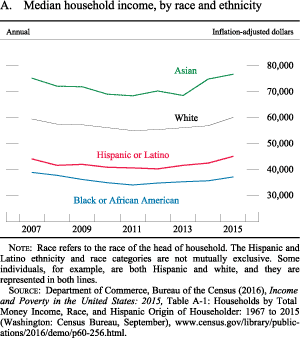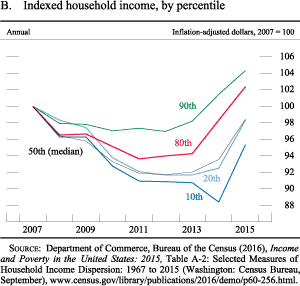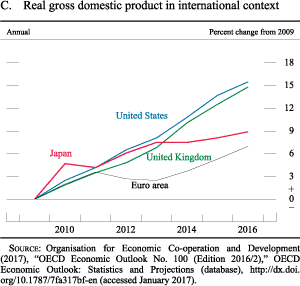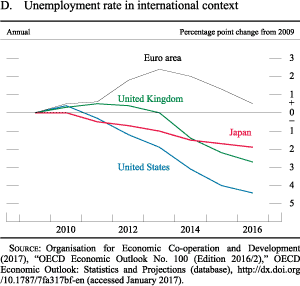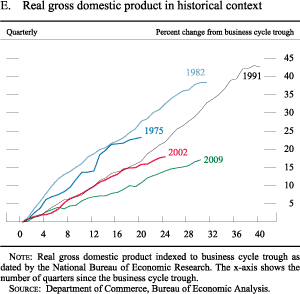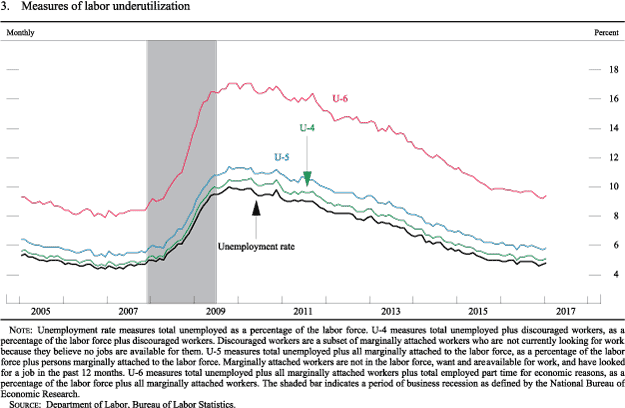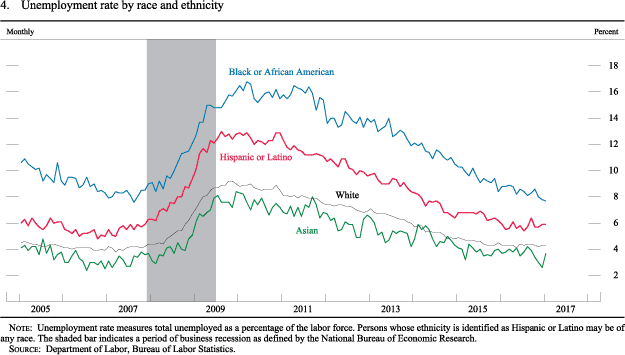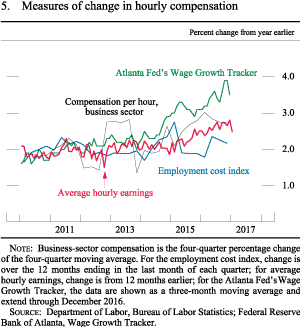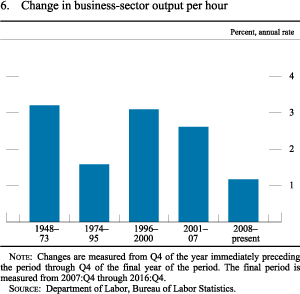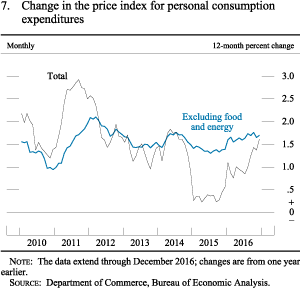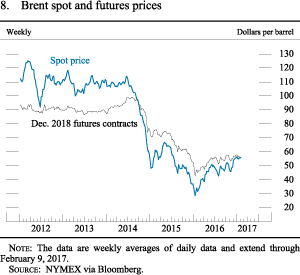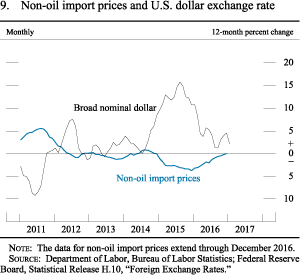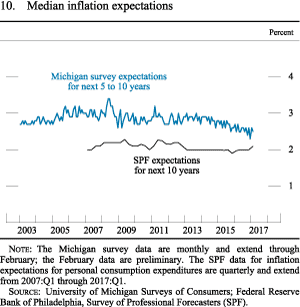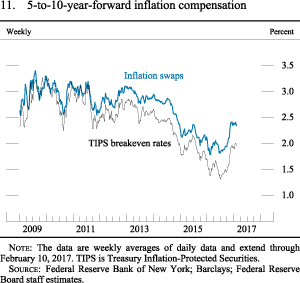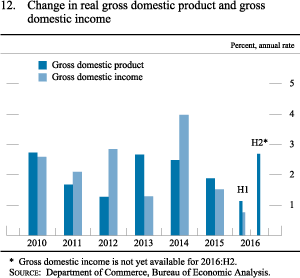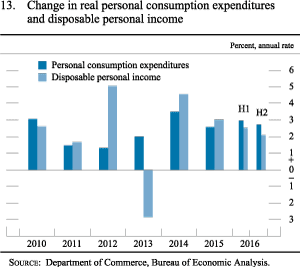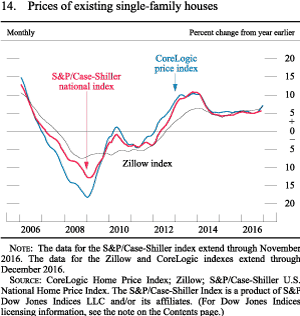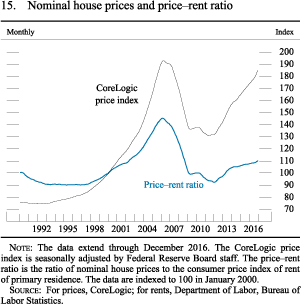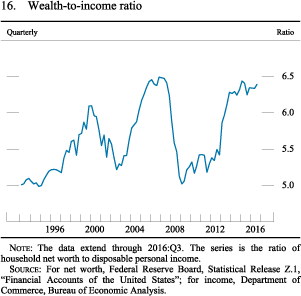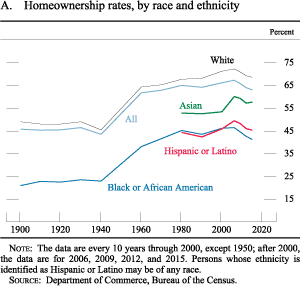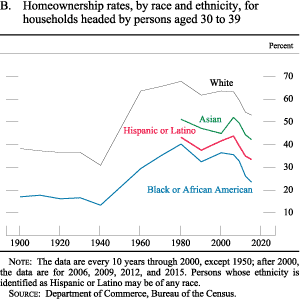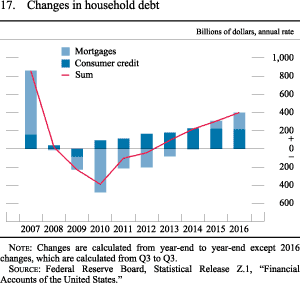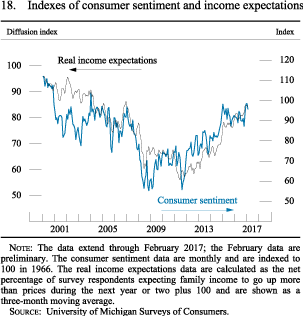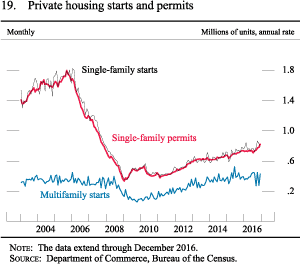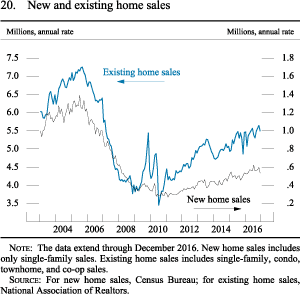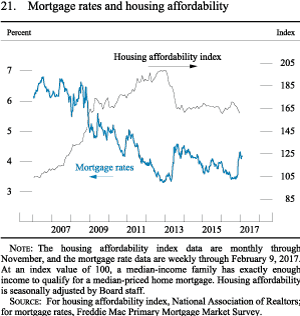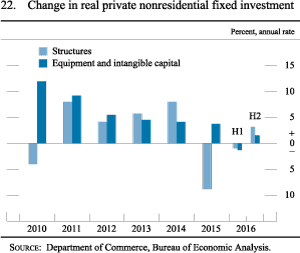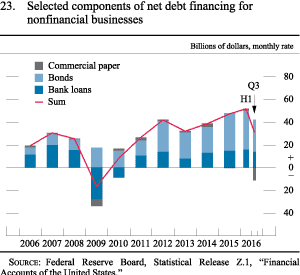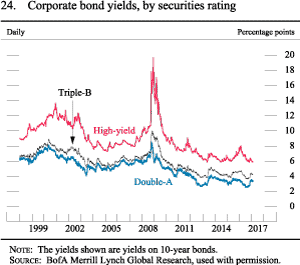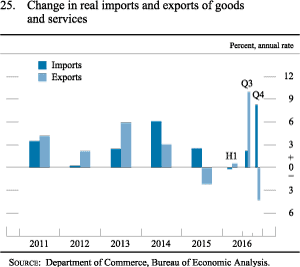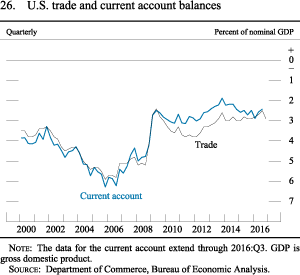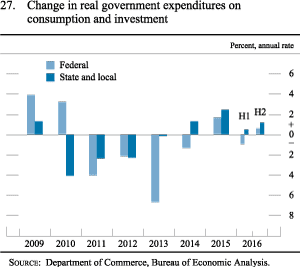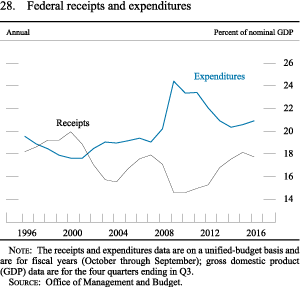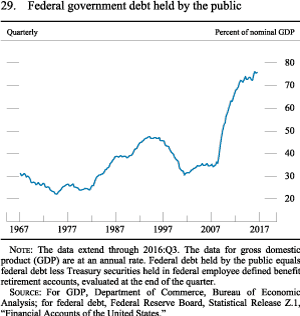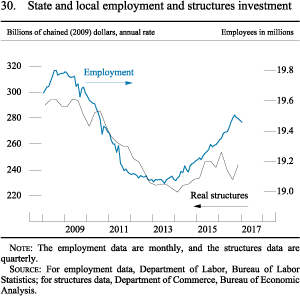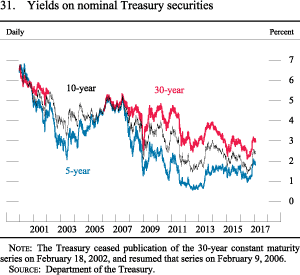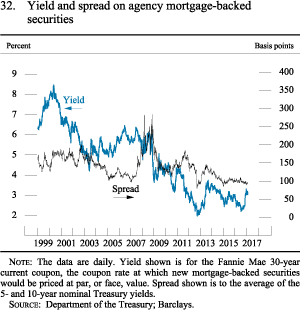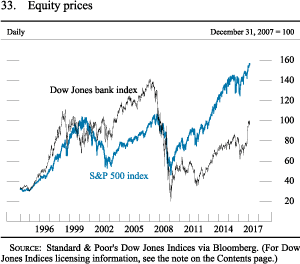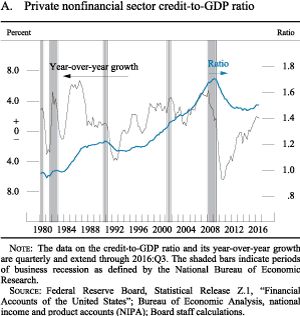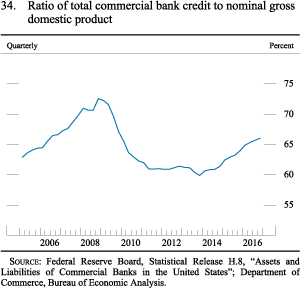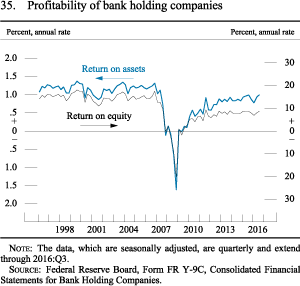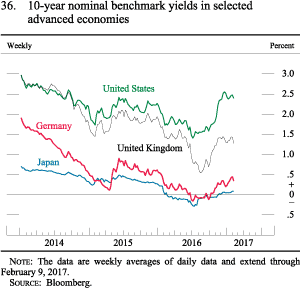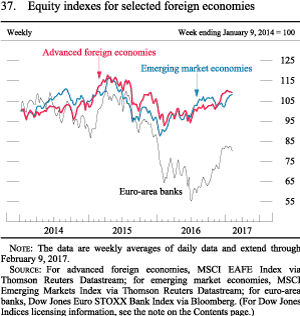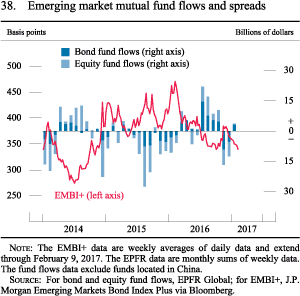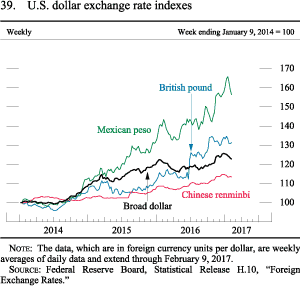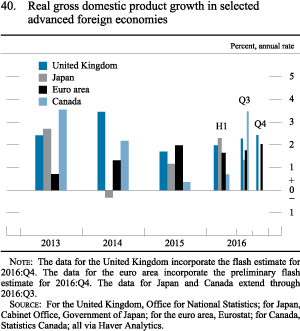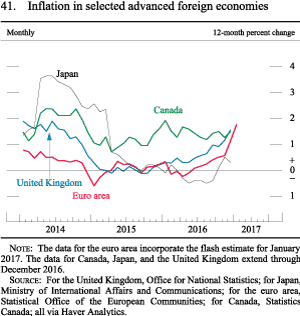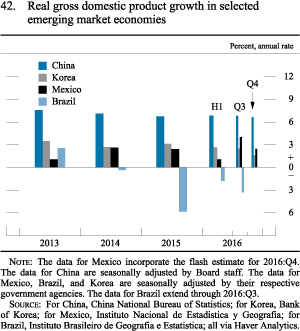- February 14, 2017: Summary
- Part 1
- Part 2
- Part 3
- Abbreviations
- Printable Version (1.26 MB PDF)

Sections of Part 1
Part 1: Recent Economic and Financial Developments
Monetary Policy Report submitted to the Congress on February 14, 2017, pursuant to section 2B of the Federal Reserve ActLabor market conditions continued to improve during the second half of last year and early this year. Payroll employment has increased 200,000 per month, on average, since June, and the unemployment rate has declined slightly further, reaching 4.8 percent in January, in line with the median of Federal Open Market Committee (FOMC) participants' estimates of its longer-run normal level. The labor force participation rate has edged higher, on net, which is all the more notable given a demographically induced downward trend.
The 12-month change in the price index for overall personal consumption expenditures (PCE) was 1.6 percent in December--still below the Committee's 2 percent objective but up noticeably from 2015, when the increase in top-line prices was held down by declines in energy prices. The 12-month change in the index excluding food and energy prices (the core PCE price index) was 1.7 percent last year. Measures of longer-term inflation expectations have been generally stable, though some survey-based measures remain lower than a few years ago; market-based measures of inflation compensation moved higher in recent months but also remain below their levels from a few years ago.
Real gross domestic product (GDP) is estimated to have increased at an annual rate of 2-3/4 percent over the second half of 2016 after increasing just 1 percent in the first half. The economic expansion continues to be supported by accommodative financial conditions--including the still-low cost of borrowing for many households and businesses--and gains in household net wealth, which has been boosted further by a rise in the stock market in recent months and by increases in households' real income spurred by continuing job gains. However, net exports were a moderate drag on GDP growth in the second half, as imports picked up and the rise in the exchange value of the dollar in recent years remained a drag on export demand.
Domestic Developments
The labor market has continued to tighten gradually...
Labor market conditions strengthened over the second half of 2016 and early this year. Payroll employment has continued to post solid gains, averaging 200,000 per month since last June (figure 1). This rate of job gains is a bit higher than that seen during the first half of 2016, though it is a little slower than the 225,000 monthly pace in 2015. The unemployment rate has declined slightly further, on net, since the middle of last year. After dipping as low as 4.6 percent in November, the unemployment rate stood at 4.8 percent in January, in line with the median of FOMC participants' estimates of its longer-run normal level.
The labor force participation rate, at 62.9 percent, is up slightly since June 2016. Changing demographics and other longer-run structural changes in the labor market likely have continued to put downward pressure on the participation rate. A flat or increasing trajectory of the participation rate should therefore be viewed as a cyclical improvement relative to that downward trend. Reflecting the slightly higher participation rate and the small drop in the unemployment rate, the employment-to-population ratio has moved up about 1/4 percentage point since mid-2016 (figure 2). (For additional historical context on the economic recovery, see the box "The Recovery from the Great Recession and Remaining Challenges.")
The Recovery from the Great Recession and Remaining Challenges
The Great Recession severely affected the U.S. economy...
The Great Recession of 2008 and 2009, and the financial crisis that precipitated it, resulted in massive job losses and falling incomes for American households. The Great Recession was, along many dimensions, the most severe downturn since the Great Depression almost 80 years earlier. Economic output declined outright for 18 months, leaving real gross domestic product (GDP) 4-1/2 percent below its previous peak. More than 8-1/2 million jobs were lost, on net, and the unemployment rate soared from 4-1/2 percent in 2007 to a peak of 10 percent in late 2009 (text figure 3). The labor force participation rate (LFPR), the fraction of the population either employed or counted as unemployed, fell steeply, from 66 percent in 2007 to 63 percent in 2014 (text figure 2). Household incomes tumbled, with real income for the median family declining more than 8 percent from 2007 to 2012.
The hardships were particularly acute for certain groups of Americans. As text figure 4 shows, unemployment rates for blacks and Hispanics rose considerably more during the recession than did such rates for the nation as a whole. Of particular note, inflation-adjusted median household incomes for black households declined more than 12 percent from peak to trough, substantially more in percentage terms than for white, Hispanic, or Asian households (figure A).1
...but considerable progress has been made
In the eight years since the crisis, the U.S. economy has made considerable progress across a broad range of measures; this progress has occurred while the resilience of the financial system has been shored up. More than 15 million jobs have been created, on net, since the fall of 2009, and the unemployment rate has fallen by half. In addition, the LFPR has moved roughly sideways since 2014, which should be viewed as a cyclical improvement given the demographic changes and other secular trends that have put downward pressure on participation for the past 10 years. The robust job gains seen during the current expansion are all the more noteworthy given these demographic pressures.
The labor market at present is likely close to being at full employment. The unemployment rate is near the median of Federal Open Market Committee (FOMC) participants' assessments of its longer-run normal value. In addition, real GDP now stands 11 percent above its pre-recession peak, and it is approaching, though still a bit below, the Congressional Budget Office's estimate of potential output--that is, the maximum sustainable level of economic output. 2
Incomes for the median family have mostly recovered from the Great Recession. Of note, real median income is reported to have risen 5.2 percent in 2015 (figure B).
The recovery compares favorably with those of other advanced economies. GDP has increased faster and unemployment has declined more quickly in the United States than in other major advanced economies (figures C and D). And the Federal Reserve's challenges in getting inflation back up to target are similar to, but not as severe as, those faced by some other major monetary authorities in the past few years. Although consumer price inflation, as measured by the price index for personal consumption expenditures, has run below the FOMC's 2 percent objective through most of the expansion, in recent months inflation has moved closer to the Committee's target (text figure 7).
Nonetheless, challenges remain
While much progress has been made, important challenges remain for the U.S. economy. GDP growth has averaged only about 2 percent per year during this expansion, the slowest pace of any postwar recovery (figure E). In part, that subdued pace is due to slower growth in the labor force in recent decades compared with much of the postwar period. 3
Another source of slow GDP growth has been lackluster labor productivity growth (text figure 6). Since 2008, output per hour in the business sector has risen about 1 percent per year, far below the pace that prevailed before the recession. Cyclical factors, like weak business investment and firms rebuilding workforces after cutting unusually deeply during the crisis, likely explain some of the slow rise in productivity during this expansion. But structural factors may also be at play, such as declines in innovation, reduced business dynamism, or decreased product market competition. 4 The productivity slowdown has taken place in most advanced economies, which suggests a role for structural factors not specific to the United States.
Meanwhile, despite the notable pickup in 2015, real incomes for the median family are still a bit lower than they were prior to the recession. Moreover, the gains have not been uniformly distributed; families at the 10th percentile of the income distribution earned about 4 percent less in 2015 than they did in 2007, while families at the 90th percentile earned about 4 percent more than before the Great Recession (figure B).
Similarly, the economic circumstances of blacks and Hispanics have improved since the depths of the recession, but they remain worse, on average, than those of whites or Asians. Unemployment rates for blacks and Hispanics continue to be well above those for their white and Asian counterparts (text figure 4), while incomes for these groups have stayed noticeably lower (figure A).
These challenges lie substantially beyond the reach of monetary policy to address. Monetary policy cannot, for instance, generate technological breakthroughs or address the root causes of inequality.
Footnotes
1. Measures of household income derived from surveys--such as the Current Population Survey's Annual Social and Economic Supplement, which informs the Census Bureau's official statistics--may not fully capture earned income (such as from the self-employed) and unearned income (such as transfers and retirement income). These issues are likely to be much more pronounced for the various subgroups than they are for the national median. Return to text
2. Congressional Budget Office (2017), The Budget and Economic Outlook: 2017 to 2027 (Washington: CBO, January), p. 41, www.cbo.gov/sites/default/files/115th-congress-2017-2018/reports/52370-outlook.pdf. Return to text
3. In particular, the Congressional Budget Office estimates that the contribution to potential GDP growth from trend labor force growth is 2percentage points lower today than it was 40 years ago. This development reflects a slowing of population growth and a switch from a rising LFPR to a falling one, among other factors. See Congressional Budget Office, Budget and Economic Outlook, table 2-3, p. 58, in note 2. Return to text
4. See Robert J. Gordon (2016), The Rise and Fall of American Growth: The U.S. Standard of Living since the Civil War (Princeton, N.J.: Princeton University Press); Steven J. Davis and John Haltiwanger (2014), "Labor Market Fluidity and Economic Performance," NBER Working Paper Series 20479 (Cambridge, Mass.: National Bureau of Economic Research, September); and Philippe Aghion, Nick Bloom, Richard Blundell, Rachel Griffith, and Peter Howitt (2005), "Competition and Innovation: An Inverted-U Relationship," Quarterly Journal of Economics,vol. 120 (May), pp. 701-28.
Economists are divided about the causes of the productivity slowdown and their consequences for the outlook. For an optimistic view, see Erik Brynjolfsson and Andrew McAfee (2014), The Second Machine Age: Work, Progress, and Prosperity in a Time of Brilliant Technologies (New York: W.W. Norton & Company). For a less optimistic perspective, see Gordon, Rise and Fall of American Growth,earlier in this note . Others have argued that difficulties associated with economic measurement may exaggerate the slowdown; see, for example, David M. Byrne, John G. Fernald, and Marshall B. Reinsdorf (2016), "Does the United States Have a Productivity Slowdown or a Measurement Problem?" Brookings Papers on Economic Activity, Spring, pp. 109-57, https://www.brookings.edu/wp-content/uploads/2016/03/byrnetextspring16bpea.pdf ![]() . Another, more optimistic explanation is that the slowdown in productivity reflects a "constructive pause" as firms adopt new productivity-enhancing technology and organizational practices; see, for example, Paul A. David (1990), "The Dynamo and the Computer: An Historical Perspective on the Modern Productivity Paradox," American Economic Review, vol. 80 (May), pp. 355-61. Return to text
. Another, more optimistic explanation is that the slowdown in productivity reflects a "constructive pause" as firms adopt new productivity-enhancing technology and organizational practices; see, for example, Paul A. David (1990), "The Dynamo and the Computer: An Historical Perspective on the Modern Productivity Paradox," American Economic Review, vol. 80 (May), pp. 355-61. Return to text
...and is close to full employment
Other indicators are also consistent with a healthy labor market. Layoffs as a share of private employment, as measured in the Job Openings and Labor Turnover Survey (JOLTS), remained at a low level through December, and recent readings on initial claims for unemployment insurance, a more timely measure, point to a very low pace of involuntary separations. The JOLTS quits rate has generally continued to trend up and is now close to pre-crisis levels, indicating that workers feel increasingly confident about their employment opportunities. In addition, the rate of job openings as a share of private employment has remained near record-high levels. The share of workers who are employed part time but would like to work full time--which is part of the U-6 measure of underutilization from the Bureau of Labor Statistics (BLS)--is still somewhat elevated, however, even though it has declined further; as a result, the gap between U-6 and the headline unemployment rate is somewhat wider than it was in the years before the Great Recession (figure 3).
The jobless rate for African Americans also continued to edge lower in the second half of 2016, while the rate for Hispanics remained flat; as with the overall unemployment rate, these rates are near levels seen leading into the recession. Despite these gains, the average unemployment rates for these groups of Americans have remained high relative to the aggregate, and those gaps have not narrowed over the past decade (figure 4).
Labor compensation growth is picking up...
The improving labor market appears to be contributing to somewhat larger gains in labor compensation. Major BLS measures of hourly compensation posted larger increases last year. Of these, the measures that include the costs of benefits have posted smaller gains than wage-only measures because of a slowdown in the growth of employer health-care costs. A compensation measure computed by the Federal Reserve Bank of Atlanta, which tracks only the wages of workers who were employed at two points in time spaced 12 months apart, shows even more pickup than these BLS measures (figure 5).
...amid persistently slow productivity growth
As in the previous several years, gains in labor compensation last year occurred against a backdrop of persistently slow productivity growth. Since 2008, labor productivity gains have averaged around 1 percent per year, well below the pace that prevailed from the mid-1990s to 2007 and somewhat below the 1974-95 average of 1-1/2 percent per year (figure 6). Since 2011, output per hour has averaged only a little more than 1/2 percent per year. The relatively slow pace of productivity growth in recent years is in part a consequence of the slower pace of capital accumulation; diminishing gains in technological innovations and downward trends in business formation also may have played a role.
Price inflation has picked up over the past year...
In recent years inflation has been persistently low, in part because the drop in oil prices and the rise in the exchange value of the dollar since mid-2014 have led to sharp declines in energy prices and relatively weak non-energy import prices. The effects of these earlier developments have been waning, however, and overall inflation has been moving up toward the FOMC's 2 percent target; the 12-month change in overall PCE prices reached 1.6 percent in December, compared with only 0.6 percent over 2015. The PCE price index excluding food and energy items, which provides a better indication than the headline figure of where overall inflation will be in the future, rose 1.7 percent over the 12 months ending in December, somewhat greater than the 1.4 percent increase in the prior year, as prices for a wide range of core goods and services accelerated. Nonetheless, the rate of inflation for both total and core PCE prices remains below the Committee's target (figure 7).
...as oil and other commodity prices moved up moderately
The similar readings for headline and core PCE inflation last year partly reflect an upturn in crude oil in 2016 following the sharp decline in the prior two years. Since July, oil prices traded mostly in the $45 to $50 per barrel range until the November OPEC agreement regarding production cuts in 2017 (figure 8). In the wake of that agreement, prices moved up to about $55, roughly $15 per barrel higher since late 2015. Retail gasoline prices also rose after the November OPEC agreement, but that increase has partially reversed in recent weeks.
After falling during 2014 and 2015, non-oil import prices stabilized in late 2016, supported by the rise in nonfuel commodity prices as well as by an uptick in foreign inflation (figure 9). In particular, prices of metals have increased in the past few months, boosted by production cuts combined with improved prospects for demand both in the United States and abroad. However, factors holding non-oil import prices down include dollar appreciation in the second half of 2016 and lower prices of agricultural goods last fall, as U.S. harvests hit record-high levels for many crops.
Survey measures of longer-term inflation expectations have been generally stable...
Wage- and price-setting decisions are likely influenced by expectations for inflation. Surveys of professional forecasters outside the Federal Reserve System indicate that their longer-term inflation expectations have remained stable and consistent with the FOMC's 2 percent objective for PCE inflation. In contrast, the median inflation expectation over the next 5 to 10 years as reported by the University of Michigan Surveys of Consumers has generally trended downward over the past few years, though it is little changed from a year ago; this measure was at 2.5 percent in early February (figure 10). It is unclear how best to interpret that downtrend; this measure of inflation expectations has been above actual inflation for much of the past 20 years.
...and market-based measures of inflation compensation have moved up notably in recent months but also remain relatively low
TIPS-based inflation compensation (5 to 10 years forward), after declining to very low levels through the middle of 2016, has risen to nearly 2 percent and is about 20 basis points higher than it was at the end of 2015. However, this level is still below the 2-1/2 to 3 percent range that persisted for most of the 10 years prior to 2014 (figure 11).
Real GDP growth picked up in the second half of 2016
Real GDP is reported to have increased at an annual rate of 2-3/4 percent in the second half of 2016 after increasing just 1 percent in the first half (figure 12). Much of the step-up reflects the stabilization of inventory investment, which held down GDP growth considerably in the first half of last year, as well as a pickup in government purchases of goods and services. Private domestic final purchases--that is, final purchases by U.S. households and businesses--grew more steadily than GDP last year and posted a fairly solid gain in the second half. PCE growth was bolstered by rising incomes and wealth, while private fixed investment was weak despite the low costs of borrowing for many households and businesses. Although the FOMC has increased the federal funds rate twice as this expansion has progressed--once in December 2015 and again in December 2016--in 1/4 percentage point steps, overall financial conditions have been sufficiently accommodative to support somewhat-faster-than-trend growth in real activity.
Gains in income and wealth have continued to support consumer spending...
Real consumer spending rose at an annual rate of 2-3/4 percent in the second half of 2016, a solid pace similar to the one seen in the first half. Consumption has been supported by the ongoing improvement in the labor market and the associated increases in real disposable personal income (DPI)--that is, income after taxes and adjusted for price changes. Real DPI increased 2-1/4 percent in 2016 following a gain of 3 percent in 2015, when purchasing power was boosted by falling energy prices (figure 13).
Consumer spending has also been supported by further increases in household net worth. Broad measures of U.S. equity prices rose solidly over the past year, and house prices continued to move up (figure 14). (In nominal terms, national house prices are approaching their peaks of the mid-2000s, though relative to rents or income, house price valuations are much lower than a decade ago (figure 15).) Buoyed by these cumulative increases in home and equity prices, aggregate household net worth has risen appreciably from its level during the recession, and the ratio of household net worth to income remains well above its historical average (figure 16). The benefits of homeownership have not been distributed evenly; see the box "Homeownership by Race and Ethnicity."
Homeownership by Race and Ethnicity
Most households in the United States own their homes, and among those who do not, many continue to aspire to own their homes. 1 The popularity of homeownership may stem from the amenities and financial benefits that are associated with ownership. For example, on the financial side, owning a home protects households against volatility in rental prices and may help them build wealth as they repay their mortgage. 2 Historically, we have seen disparities in homeownership across racial and ethnic groups, and these disparities are an important dimension of racial inequality in the United States. 3
Nationally representative data from 1900 through 2015 indicate that the overall homeownership rate rose sharply from 1940 to 1960 (figure A). 4 Research suggests that this surge in homeownership reflected a combination of factors, including the postwar economic boom and an easing of terms for mortgage credit (such as reduced down payment requirements and longer terms to maturity) through government-backed lending programs run by the Federal Housing Administration and the Veterans Administration. 5 The homeownership rate then edged up slightly further, on net, between 1960 and 2006. However, since the onset of the housing crash and the financial crisis in 2007, the homeownership rate has declined as foreclosures became elevated for several years and first-time homebuying dropped and remained subdued. 6
These post-crisis declines in homeownership have been similar for white, black, and Hispanic households and somewhat smaller for Asian households. 7 Thus, the large gaps between the homeownership rates of white households and those of black and Hispanic households have held steady, while the smaller gap between white and Asian households has narrowed slightly. Perhaps the most striking feature of the data is the persistence of the black-white homeownership gap, which has measured about 25 to 30 percentage points throughout the past 115 years. Potential reasons for this persistence will be discussed shortly.
The likelihood of owning one's home rises with age. Thus, the aging of the U.S. population contributed to increasing homeownership before 2006 and would have caused the homeownership rate to continue rising after 2006, all else being equal. Examining the data separately by age group reveals homeownership trends that differ from overall averages, with stronger declines in homeownership observed for young and middle-aged households. For example, among households headed by a person 30 to 39 years old, homeownership rates fell more than 10 percentage points between 2006 and 2015 for all major races and ethnicities (figure B). 8 For both white and black households in this age range, the homeownership rate peaked in 1980, much earlier than the overall national average; by 2015, it stood well below its level in 1960. Over the past century, the black-white homeownership gap has actually widened for households in this age range.
In light of the gains in education, income, and access to credit and housing over the long term for minorities in the United States, the persistence of the black-white gap is surprising. A considerable amount of academic research has sought to better understand differences in homeownership rates across racial and ethnic groups. 9 Many factors have been found to influence the likelihood of homeownership, and some of these may have had offsetting effects on the black-white gap. For example, from 1940 to 1960, the migration of many black families from the South to northern central cities (where owning a home was less likely regardless of race) tended to offset the positive effects on the homeownership rate from gains in income and education. 10
In more recent decades, the relative rise in the fraction of black households headed by a single parent may have offset factors that otherwise would have generated increases in homeownership rates, including the introduction and enforcement of anti-discrimination laws, such as the Equal Credit Opportunity Act and the Fair Housing Act. Research on the black-white and Hispanic-white gaps indicates that a large portion of these gaps in recent years can be attributed to socioeconomic differences--such as age, income, and family structure--across groups. 11 That said, some of the overall gap is not explainable on the basis of those variables and could reflect other factors such as location and housing preferences; it also could reflect continued discrimination in housing and credit markets. 12 Finally, recent research has also documented larger differences in credit scores between whites and minorities than can be explained by income disparities; thus, the tighter mortgage credit environment that prevails today relative to a dozen or more years ago could cause the homeownership gap to widen in the near term. 13
Footnotes
1. A 2014 survey indicated that over 90 percent of young renters reported that they intended to purchase a home in the future. See Fannie Mae (2014), Fannie Mae National Housing Survey: What Younger Renters Want and the Financial Constraints They See (Washington: Fannie Mae, May), www.fanniemae.com/resources/file/research/housingsurvey/pdf/nhsmay2014presentation.pdf. Return to text
2. See Todd Sinai and Nicholas S. Souleles (2005), "Owner-Occupied Housing as a Hedge against Rent Risk," The Quarterly Journal of Economics, vol. 120 (2), pp. 763-89; see also David Laibson (1997), "Golden Eggs and Hyperbolic Discounting," Quarterly Journal of Economics, vol. 112 (2), pp. 443-78. Of course, as the financial crisis made clear, homeownership carries risks as well. For example, highly leveraged homeowners are at risk of negative equity if house prices decline, which tends to impede mobility; see Fernando Ferreira, Joseph Gyourko, and Joseph Tracy (2010), "Housing Busts and Household Mobility," Journal of Urban Economics, vol. 68 (July), pp. 34-45. Return to text
3. Following standard practice, the homeownership rate is calculated here as the fraction of households that own their home. Thus, trends in household formation influence trends in the homeownership rate, and declining household formation in recent years has helped support the homeownership rate. See Andrew Paciorek (2016), "The Long and Short of Household Formation," Real Estate Economics, vol. 44 (1), pp. 7-40. Return to text
4. The data are decennial census data from 1900 through 2000 as well as American Community Survey (ACS) data from 2006, 2009, 2012, and 2015. For individual-level census and ACS data, see Steven Ruggles, Katie Genadek, Ronald Goeken, Josiah Grover, and Matthew Sobek (2015), Integrated Public Use Microdata Series: Version 6.0 [machine-readable database] (Minneapolis: University of Minnesota). The ACS has been conducted annually by the U.S. Census Bureau since 2000. Data on homeownership are not available in the 1950 census data. Return to text
5. See Daniel K. Fetter (2014), "The Twentieth-Century Increase in U.S.: Facts and Hypotheses," in EugeneN. White, Kenneth Snowden, and Price Fishback, eds., Housing and Mortgage Markets in Historical Perspective (Chicago: University of Chicago Press). Return to text
6. See Neil Bhutta (2015), "The Ins and Outs of Mortgage Debt during the Housing Boom and Bust," Journal of Monetary Economics,vol. 76, pp. 284-98. Return to text
7. Households are classified by race and ethnicity according to the race and ethnicity of the household head, defined here as either the survey respondent or the spouse of the respondent if older. The Hispanic ethnicity and race categories are not mutually exclusive. Some individuals are, for example, both Hispanic and white. The Asian category includes Pacific Islanders. Homeownership rates for Hispanic and Asian households are not shown before 1980 because, prior to 1980, Hispanic status was not asked about directly and the Asian population was quite small. Return to text
8. For more complete data on homeownership rates by age since 1900, see Laurie Goodman, Rolf Pendall, and Jun Zhu (2015), Headship and Homeownership: What Does the Future Hold? (Washington: Urban Institute, June), www.urban.org/sites/default/files/2000257-headship-and-homeownership-what-does-the-future-hold.pdf ![]() . Return to text
. Return to text
9. For a review of the literature, see Donald R. Haurin, Christopher E. Herbert, and Stuart S. Rosenthal (2007), "Homeownership Gaps among Low-Income and Minority Households," Cityscape, vol. 9 (2), pp. 5-52. Return to text
10. See William J. Collins and Robert A. Margo (2001), "Race and Home Ownership: A Century-Long View," Explorations in Economic History, vol. 38 (January), pp. 68-92. Return to text
11. See Stuart A. Gabriel and Stuart S. Rosenthal (2005), "Homeownership in the 1980s and 1990s: Aggregate Trends and Racial Gaps," Journal of Urban Economics, vol. 57 (January), pp. 101-27; and Eric Fesselmeyer, Kien T. Le, and Kiat Ying Seah (2012), "A Household-Level Decomposition of the White-Black Homeownership Gap," Regional Science and Urban Economics,vol. 42 (January), pp. 52-62. Return to text
12. See Kerwin Kofi Charles and Erik Hurst (2002), "The Transition to Home Ownership and the Black-White Wealth Gap," Review of Economics and Statistics, vol. 84 (May), pp. 281-97. Return to text
13. See Neil Bhutta and Daniel Ringo (2016), "Credit Availability and the Decline in Mortgage Lending to Minorities after the Housing Boom," FEDS Notes (Washington: Board of Governors of the Federal Reserve System, September 29), https://www.federalreserve.gov/econresdata/notes/feds-notes/2016/credit-availability-and-the-decline-in-mortgage-lending-to-minorities-after-the-housing-boom-20160929.html. For additional research on heightened credit score thresholds in recent years, see Steven Laufer and Andrew Paciorek (2016), "The Effects of Mortgage Credit Availability: Evidence from Minimum Credit Score Lending Rules," Finance and Economics Discussion Series 2016-098 (Washington: Board of Governors of the Federal Reserve System, December), https://www.federalreserve.gov/econresdata/feds/2016/files/2016098pap.pdf. Return to text
...as does credit availability
Consumer credit has continued to expand somewhat faster than income amid stable delinquencies on consumer debt (figure 17). Auto and student loans remain widely available even to borrowers with lower credit scores, and outstanding balances on these types of loans continued to expand at a robust pace. Credit card balances continued to grow and were 6 percent higher than one year earlier in December. That said, credit card standards have remained tight for nonprime borrowers. As a result, delinquencies on credit cards are still near low historical levels.
Consumer confidence is strong
Household spending has also been supported by favorable consumer sentiment. In 2015 and through most of 2016, readings from the overall index of consumer sentiment from the Michigan survey were solid, likely reflecting rising incomes and job gains. Sentiment has improved further in the past couple of months (figure 18). The share of households expecting real income gains over the next year or two is now close to its pre-recession level despite having lagged improvements in the headline sentiment measure earlier in the recovery.
Housing construction has been sluggish despite rising home demand
Residential investment spending appears to have only edged higher in 2016 following a larger gain in the previous year. Single-family housing starts registered a moderate increase in 2016, while multifamily housing starts flattened out on balance (figures 19). The pace of construction activity in 2016 remained sluggish despite solid gains in house prices and ongoing improvements in demand for both new and existing homes (figure 20). As a result, the months' supply of inventories of homes for sale dropped to low levels, and the aggregate vacancy rate moved to its lowest level since 2005. Reportedly, tight supplies of skilled labor and developed lots have been restraining home construction.
Homebuying and residential construction have been supported by low interest rates and ongoing easing of credit standards for mortgages. Banks indicated in the October 2016 Senior Loan Officer Opinion Survey on Bank Lending Practices (SLOOS) that they eased standards on several categories of residential home purchase loans. 1 Even so, mortgage credit is still relatively difficult to access for borrowers with low credit scores, harder-to-document income, or high debt-to-income ratios. Although mortgage rates moved up from their all-time low levels over the second half of last year, they remain quite low by historical standards, and, consequently, housing affordability remains favorable (figure 21).
Business investment may be turning up after a period of surprising weakness
Real outlays for business investment--that is, private nonresidential fixed investment--were generally weak in 2016 but posted larger gains toward the end of the year (figure 22). Last year's weakness occurred despite moderate increases in aggregate demand and generally favorable financing conditions, and it was widespread across categories of equipment investment. Investment in equipment and intangibles moved down over most of the year, likely reflecting the effects of the combination of low oil prices, weak export demand, and a muted longer-run demand outlook among businesses. Although such declines are unusual outside of a recession, spending on these items did turn up in the fourth quarter. Investment in drilling and mining structures, which had been falling sharply since the drop in oil prices in 2014, fell further through most of 2016 but seems to be bottoming out. Outside of the energy sector, investment in nonresidential structures increased moderately in 2016. Finally, after having been subdued for much of 2016, a widespread set of business sentiment indicators improved notably near the end of last year.
Financing conditions for nonfinancial firms have generally remained favorable
Nonfinancial businesses have continued to raise funds through bond issuance and bank loans, albeit at a somewhat slower pace than in the first half of 2016 (figure 23). The pace of such borrowing was supported in part by continued low interest rates: Corporate bond yields for speculative-grade borrowers have declined since last June, and those for investment-grade borrowers have increased but a fair bit less than those on comparable-maturity Treasury securities (figure 24). Banks indicated in the October 2016 and January 2017 SLOOS that they eased lending terms on commercial and industrial loans in the second half of the year, but that standards on such loans remained unchanged relative to earlier in 2016; banks continued to tighten standards on commercial real estate loans over the second half of last year.
Net exports held down second-half real GDP growth
The rise in the dollar since mid-2014 and subdued foreign economic growth have continued to weigh on U.S. exports (figure 25). Nevertheless, exports increased at a moderate pace in the second half of 2016, but with much of the increase a result of rising agricultural exports. In particular, soybean exports surged in the third quarter before falling back toward a more normal level in the fourth quarter. Consistent with the stronger exchange value of the dollar, imports jumped in the second half of the year after having been about flat in the first half, when investment demand for imported equipment was very weak. Overall, real net exports were a moderate drag on real GDP growth in the second half of 2016. Although the trade balance and current account deficit narrowed slightly in the second and third quarters of 2016, the trade balance widened in the fourth quarter, as imports significantly outpaced exports (figure 26).
Federal fiscal policy was a roughly neutral influence on GDP growth in 2016...
After being a drag on aggregate demand during much of the expansion, discretionary changes in federal fiscal policy have had a more neutral influence over the past two years. During 2016, policy actions had little effect on taxes and transfers, and federal purchases of goods and services are little changed over this period (figure 27). The federal budget deficit increased in fiscal year 2016 to 3.2 percent of GDP from 2.4 percent in fiscal 2015. Revenues rose only 1 percent last year in nominal terms and fell as a share of GDP because of soft personal income tax revenues and a decline in corporate income tax collections. Outlays rose 5 percent, edging up as a share of GDP, owing to increases in mandatory spending and interest payments as well as a shift in the timing of some payments that ordinarily would have been made in fiscal 2017 (figure 28). The Congressional Budget Office forecasts the deficit to be about the same size (as a share of GDP) in fiscal 2017 and in the next couple of years before rising thereafter. Consequently, the ratio of debt held by the public to nominal GDP is projected to remain near its current level of 77 percent of GDP for the next couple of years and then begin to rise (figure 29).
...and real purchases at the state and local level continue to increase, albeit at a tepid pace
The fiscal conditions of most state and local governments have continued to improve, though the pace of improvement has been slower in recent quarters than it had been previously. The ongoing improvement facilitated a step-up in the average pace of employment gain in the sector to the strongest rate since 2008. At the same time, however, real investment in structures by state and local governments has declined, on net, since the first quarter of 2016 after trending up during the prior two years (figure 30). All told, total real state and local purchases rose anemically in 2016. On the other side of the ledger, revenue growth was subdued overall, with little growth in tax collections at the state level but moderate gains at the local level.
Financial Developments
The expected path for the federal funds rate over the next several years steepened
Against the backdrop of continued strengthening in the labor market and an increase in inflation over the course of 2016, the path of the federal funds rate implied by market quotes on interest rate derivatives has moved up, on net, since the middle of last year. Following the U.S. elections in November, the expected policy path in the United States steepened significantly, apparently reflecting investors' expectations of a more expansionary fiscal policy. Meanwhile, market-based measures of uncertainty about the policy rate approximately one to two years ahead also increased, on balance, suggesting that some of the firming in market rates may reflect a rise in term premiums.
Survey-based measures of the expected path of policy also moved up in recent months. In the Survey of Primary Dealers that was conducted by the Federal Reserve Bank of New York just prior to the January 2017 FOMC meeting, the median dealer expected two rate hikes in 2017 and three rate hikes in 2018 as the most likely outcome.2
U.S. nominal Treasury yields increased considerably
After dropping significantly during the first half of 2016 and reaching near-historical lows in the aftermath of the U.K. referendum on exit from the European Union, or Brexit, in June, yields on medium- and longer-term nominal Treasury securities rebounded strongly in the second half of last year, with a substantial rise following the U.S. elections (figure 31). Market participants have attributed the increase in yields following the elections primarily to expectations of a more expansionary fiscal policy. The boost in longer-term nominal yields in recent months reflects roughly equal increases in real yields and inflation compensation. Consistent with the changes in Treasury yields, yields on 30-year agency mortgage-backed securities (MBS)--an important determinant of mortgage interest rates--increased significantly over the second half of the year (figure 32). However, Treasury and MBS yields remain quite low by historical standards.
Broad equity price indexes increased notably...
U.S. equity markets were volatile around the Brexit vote in the United Kingdom but operated without disruptions. Broad equity price indexes have increased notably since late June, with a sizable portion of the gain occurring after the U.S. elections in November (figure 33). Reportedly, equity prices have been supported in part by the perception that corporate tax rates may be reduced. Stock prices of banks, which tend to benefit from a steepening in the yield curve, outperformed the broader market. Moreover, market participants pointed to expectations of changes in the regulatory environment as a factor contributing to the outperformance of bank stocks. By contrast, stock prices of firms that tend to benefit from lower interest rates, such as utilities, declined moderately on net. The implied volatility of the S&P 500 index--the VIX-- fell, ending the period close to the bottom of its historical range. (For a discussion of financial stability issues over this same period, see the box "Developments Related to Financial Stability.")
Developments Related to Financial Stability
Financial vulnerabilities in the U.S. financial system overall have continued to be moderate since mid-2016. U.S. banks are well capitalized and have sizable liquidity buffers. Nonfinancial corporate business leverage has remained elevated by historical standards, and household borrowing has increased modestly, leaving the household debt-to-income ratio about unchanged. On balance, the ratio of aggregate nonfinancial credit to gross domestic product (GDP) has moved up a little in recent years to about its level in the mid-2000s but remains well below its recent peak. Valuation pressures in some asset classes have been rising, particularly late last year.
Vulnerabilities stemming from leverage in the financial sector appear low. Regulatory capital has remained at historically high levels for most large domestic banks, and all 33 firms participating in the Federal Reserve's supervisory stress tests for 2016 were able to maintain capital ratios above required minimums through the severely adverse recession scenario. 1 Moreover, market-based measures of leverage for domestic banks have decreased somewhat since November. However, valuations of many of the largest foreign banks remain depressed. Despite the settlement on December 23 between Deutsche Bank and the U.S. Department of Justice and some progress toward addressing problems in the Italian banking sector, several large European financial institutions have continued to be vulnerable to unexpected developments. Available data suggest that the leverage of nonbank financial institutions was relatively stable in the second half of 2016.
On balance, vulnerabilities associated with liquidity and maturity transformation are also somewhat below their longer-run average. The reliance of large bank holding companies on short-term funding remains subdued, and their holdings of high-quality liquid assets are robust, owing in part to the implementation of the Liquidity Coverage Ratio. Money market mutual fund (also referred to as money market fund, or MMF) reforms designed to reduce the advantages associated with being the first to exit a fund in times of financial stress led to large declines in prime MMF assets under management, with most of these funds migrating to government MMFs. While the resulting smaller size of prime funds and the new regulations should make the industry more stable, the longer-term effect will depend on the degree to which such activity migrates to other types of short-term investment vehicles that may be subject to similar fragilities.
Asset valuation pressures have increased, on balance, since mid-2016, along with several indicators of investors' risk appetite. Although yields on Treasury securities and term premiums increased as market expectations about future growth shifted higher in the fall, they both remain low. In addition, the spread of yields on corporate bonds over those on comparable-maturity Treasury securities narrowed. Estimates of risk premiums in equity markets also declined. Outstanding riskier corporate debt edged down over the past year, but gross issuance of leveraged loans was strong and the share of bond issuance rated B or below remained in the fourth quarter at the high end of its range over the past few years. Commercial real estate (CRE) valuations, which have been an area of growing concern over the past year, rose further, with property prices continuing to climb and capitalization rates decreasing to historically low levels. While CRE debt remains modest relative to the overall size of the economy and the tightening in bank lending standards for CRE loans in the second half of last year may reflect some reduction in the appetite for CRE lending, the heightening of valuation pressures may leave some smaller banks vulnerable to a sizable CRE price decline. Also, residential home prices continued to rise briskly through November. Although most measures of residential valuation have moved up somewhat, they are still only modestly above the levels that would be predicted, given rents and investment costs. The results of the Federal Reserve's 2017 stress tests, for which the scenarios were released on February 3, will help gauge the vulnerability of large U.S. banks to all of these asset valuation pressures.
Vulnerabilities stemming from private nonfinancial-sector borrowing remain moderate. The credit-to-GDP ratio for the corporate sector is elevated after several years of rapid growth. Despite this high leverage, interest-expense ratios are low by historical standards even among higher-risk firms, as are measures of expected default based on accounting and stock return data, especially outside of the oil sector. Turning to households, debt growth was modest through the third quarter of 2016, and the debt-to-income ratio has changed little over the past few years. Except for a recent increase in early-payment delinquencies in subprime auto loans--a small segment of overall indebtedness--broad indicators of household solvency have remained within historical norms. On balance, the private nonfinancial-sector credit-to-GDP ratio is far below the levels seen late last decade and lies near its level in the mid-2000s (figure A).
Last fall, the Federal Reserve Board finalized its framework for setting the Countercyclical Capital Buffer (CCyB) and later voted to maintain the CCyB at zero. 2 In forming its view about the appropriate size of the U.S. CCyB, the Board intends to monitor a wide range of financial and economic indicators and consider their implications for financial system vulnerabilities, including but not limited to asset valuation pressures, risk appetite, leverage in the financial and nonfinancial sectors, and maturity and liquidity transformation in the financial sector. The decision to maintain the CCyB at zero in part reflected an assessment that vulnerabilities associated with financial-sector leverage were at the lower end of their historical ranges.
As part of its effort to improve the resilience of financial institutions and overall financial stability, the Board has also taken several further regulatory steps. Among those steps is that the Board finalized a rule that would impose total loss-absorbing capacity and long-term debt requirements on U.S. global systemically important bank holding companies (G-SIBs) and on the U.S. operations of certain foreign G-SIBS. 3 The final rule would require each covered firm to maintain a minimum amount of unsecured long-term debt that could be converted into equity in a possible resolution of that firm, thereby recapitalizing the firm without putting taxpayer funds at risk and diminishing the threat that its failure would pose to financial stability.
In addition, the Board completed an extensive review of its statutory stress test and Comprehensive Capital Analysis and Review (CCAR) programs and made some related modifications to the rules associated with those programs for the 2017 cycle. 4 Among other changes, the Board removed certain large, noncomplex firms from the qualitative assessment of the CCAR. 5 Moreover, the Board, together with the other federal banking agencies, issued an advance notice of proposed rulemaking, inviting public comment on a set of potential enhanced cybersecurity risk-management and resilience standards that would apply to depository institutions and regulated holding companies with over $50 billion in assets and to certain financial market infrastructure companies. 6 The standards would be tiered, with an additional set of higher standards for systems that provide key functionality to the financial sector.
The Board and the Federal Deposit Insurance Corporation (FDIC) also have continued to actively engage in the resolution-planning process with the largest banks. As part of that process, the Board and the FDIC announced that Bank of America, BNY Mellon, JPMorgan Chase, and State Street adequately remediated deficiencies in their 2015 resolution plans. The two agencies also announced that Wells Fargo did not adequately remedy all of its deficiencies and will be subject to restrictions on certain activities until the deficiencies are remedied. 7
Footnotes
1. The 2016 supervisory stress-test methodology and results are available on the Board's website at https://www.federalreserve.gov/bankinforeg/stress-tests/2016-supervisory-stress-test-results.htm. Return to text
2. See Board of Governors of the Federal Reserve System (2016), "Federal Reserve Board Announces It Has Voted to Affirm Countercyclical Capital Buffer (CCyB) at Current Level of 0 Percent," press release, October 24, https://www.federalreserve.gov/newsevents/press/bcreg/20161024a.htm. Return to text
3. See Board of Governors of the Federal Reserve System (2016), "Federal Reserve Board Adopts Final Rule to Strengthen the Ability of Government Authorities to Resolve in Orderly Way Largest Domestic and Foreign Banks Operating in the United States," press release, December 15, https://www.federalreserve.gov/newsevents/press/bcreg/20161215a.htm. Return to text
4. See Daniel K. Tarullo (2016), "Next Steps in the Evolution of Stress Testing," speech delivered at the Yale University School of Management Leaders Forum, New Haven, Conn., September 26, https://www.federalreserve.gov/newsevents/speech/tarullo20160926a.htm. Return to text
5. See Board of Governors of the Federal Reserve System (2017), "Federal Reserve Board Announces Finalized Stress Testing Rules Removing Noncomplex Firms from Qualitative Aspect of CCAR Effective for 2017," press release, January 30, https://www.federalreserve.gov/newsevents/press/bcreg/20170130a.htm. Return to text
6. See Board of Governors of the Federal Reserve System, Office of the Comptroller of the Currency, and Federal Deposit Insurance Corporation (2016), "Agencies Issue Advanced Notice of Proposed Rulemaking on Enhanced Cyber Risk Management Standards," joint press release, October 19, https://www.federalreserve.gov/newsevents/press/bcreg/20161019a.htm. Return to text
7. See Board of Governors of the Federal Reserve System and Federal Deposit Insurance Corporation (2016), "Agencies Announce Determinations on October Resolution Plan Submissions of Five Systemically Important Domestic Banking Institutions," joint press release, December 13, https://www.federalreserve.gov/newsevents/press/bcreg/20161213a.htm. Return to text
...while risk spreads on corporate bonds narrowed
Bond spreads in the nonfinancial corporate sector declined significantly across the credit spectrum, suggesting increased investor confidence in the outlook for the corporate sector since the middle of last year. Declines in spreads were particularly large for firms in the energy sector, likely reflecting improved prospects for U.S. producers as they continue to increase efficiency and benefit from higher prices.
Treasury market functioning and liquidity conditions in the mortgage-backed securities market were generally stable
Indicators of Treasury market functioning remained broadly stable over the second half of 2016 and early 2017. A variety of liquidity metrics--including bid-asked spreads and bid sizes--have displayed minimal signs of liquidity pressures overall, with a modest reduction in liquidity following the U.S. elections. In addition, Treasury auctions generally continued to be well received by investors. Liquidity conditions in the agency MBS market were also generally stable.
The compliance deadline for money market mutual fund reform passed in mid-October with no market disruption
In the weeks leading up to the October 14, 2016, deadline for money market mutual funds (also referred to as money market funds, or MMFs) to comply with a variety of regulatory reforms, shifts in investments from prime to government MMFs were substantial. However, the transition was smooth and without any market disruptions. Overnight Eurodollar deposit volumes fell significantly and have remained low as prime funds pulled back from lending in this market. Meanwhile, the rise in total assets of government funds appeared to contribute to modestly higher levels of take-up at the overnight reverse repurchase agreement (ON RRP) facility through late 2016. Overnight money market rates were little affected, although the spread between the three-month LIBOR (London interbank offered rate) and the OIS (overnight index swap) rate has remained elevated, likely reflecting MMFs' reduced appetite for term lending.
Bank credit continued to expand, and bank profitability improved
Aggregate credit provided by commercial banks continued to grow at a solid pace in the second half of 2016 (figure 34). The expansion in bank credit was driven by strong growth in core loans coupled with an increase in banks' holdings of securities. Measures of bank profitability improved since the middle of last year but remained below their historical averages (figure 35).
Municipal bond markets continued to function smoothly
Credit conditions in municipal bond markets have generally remained stable since late June. Over that period, the MCDX--an index of credit default swap spreads for a broad portfolio of municipal bonds--decreased moderately, while yield spreads on 20-year general obligation municipal bonds over comparable-maturity Treasury securities were little changed on balance. The Puerto Rico Oversight, Management, and Economic Stability Act was passed into law in late June, providing the commonwealth with a clearer path toward debt restructuring. Although Puerto Rico missed a small amount of debt payments on general obligation bonds in August, this default appeared to have had no significant effect on the broader municipal bond market.
International Developments
Foreign financial market conditions improved despite global political uncertainties
Financial market conditions in both the advanced foreign economies (AFEs) and the emerging market economies (EMEs) have generally improved since June. In the AFEs, increasing distance from the Brexit vote, better-than-expected economic data for Europe, and the continuation of accommodative monetary policies by advanced-economy central banks have contributed to improved risk sentiment. Advanced-economy bond yields reversed their downward trend seen in the first half of the year and increased notably following the U.S. elections, in part on expectations of a more expansionary U.S. fiscal policy (figure 36).
Equity prices in the AFEs have generally risen since June, with financial stocks outperforming broader stock indexes as third-quarter earnings largely beat expectations, several major risk events passed, and the steepening of yield curves was expected to boost profits going forward (figure 37). Despite some widening of euro-area corporate spreads in the last months of 2016, corporate credit conditions in the advanced foreign economies have remained accommodative, with the continuation of corporate asset purchase programs by several AFE central banks and with low corporate spreads.
In EMEs, equities have risen significantly and sovereign yield spreads have narrowed since June, supported in part by higher commodity prices. Financial conditions did tighten briefly following the U.S. elections, with increased capital outflows and wider sovereign spreads, on concerns that higher global interest rates, as well as the possibility of more protectionist trade policies, would weigh on EME growth (figure 38). However, the favorable risk sentiment seen in the summer and early fall of 2016 resumed by the end of the year for most EMEs.
After depreciating slightly in the first half of last year, the dollar strengthened in the second half
The dollar has strengthened since June, with the broad dollar index--a measure of the trade-weighted value of the dollar against foreign currencies--rising about 4 percent on balance (figure 39). Much of this strengthening of the U.S. dollar reflects the combined influences of the large depreciation of the Mexican peso, expectations of fiscal and trade policy changes after the U.S. elections, and market expectations of tighter Federal Reserve monetary policy. The Chinese renminbi also weakened notably against the dollar, on net, as capital outflows from China picked up; Chinese authorities tightened capital controls in response.
In general, AFE economic growth was moderate and inflation remained subdued
In Canada, economic growth picked up sharply in the third quarter, following a contraction in the previous quarter, as oil extraction recovered from the disruptions caused by wildfires in May (figure 40). In contrast, economic growth in Japan in the second and third quarters slowed after a strong first quarter, returning to a more typical moderate pace. Euro-area growth firmed in the second half, and, in the United Kingdom, economic activity was resilient in the aftermath of the Brexit referendum in June. Available indicators suggest that growth in most AFEs was moderate near the end of 2016 and early this year.
Headline inflation in most AFEs increased over the second half of 2016, in part driven by higher oil prices. In the United Kingdom, the substantial sterling depreciation after the Brexit referendum also exerted upward pressure on consumer prices. Even so, core inflation readings in AFEs remained generally subdued, and headline inflation stayed below central bank targets in Canada, the euro area, Japan, and the United Kingdom (figure 41).
AFE central banks maintained highly accommodative monetary policies
In August, the Bank of England cut its policy rate 25 basis points, announced additional purchases of government and corporate bonds, and introduced a term funding scheme. In September, the Bank of Japan committed to expanding the monetary base until inflation exceeds 2 percent in a stable manner and adopted a new policy framework aimed at controlling the yield curve by targeting short- and long-term interest rates. In December, the European Central Bank announced an extension of the intended duration of its asset purchases through at least December 2017, albeit with a slight reduction in those purchases beginning in April 2017.
In EMEs, Asian growth was solid...
Chinese economic activity remained robust in the second half of 2016, as earlier policy easing supported stable manufacturing growth and a strong property market (figure 42). However, the property market cooled somewhat toward the end of the year following the introduction of new macroprudential measures aimed at curbing rapidly rising house prices. Elsewhere in emerging Asia, growth held steady in the third quarter but stepped down in some countries in the fourth, even though exports and manufacturing improved. And in India, a surprise mandatory exchange of large-denomination bank notes--a move aimed at battling tax evasion and corruption--has disrupted activity.
...but many Latin American economies continued to struggle
In Mexico, after considerable weakness in the first half of 2016, growth surged in the third quarter, supported in part by a recovery in exports to the United States. However, activity weakened again in the fourth quarter, as consumer and business confidence dropped. Furthermore, inflation in Mexico jumped over the second half of the year, pressured in part by the peso's sizable depreciation, prompting the Bank of Mexico to hike its policy rate sharply. Brazil's recession deepened in the third quarter, reflecting in part tight macroeconomic policies, although the central bank began to ease monetary policy as inflation dropped in response to the weak economy. Elsewhere in the region, activity in the third quarter was mixed; Chile's economy rebounded, but Argentina's GDP contracted and the crisis in Venezuela deepened.
Footnotes
1.The SLOOS is available on the Board's website at https://www.federalreserve.gov/boarddocs/snloansurvey. Return to text
2.The Federal Reserve Bank of New York's Survey of Primary Dealers is available at https://www.newyorkfed.org/markets/primarydealer_survey_questions.html ![]() . Return to text
. Return to text

